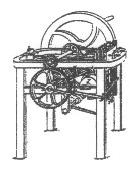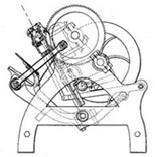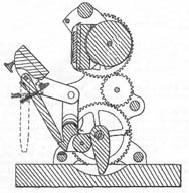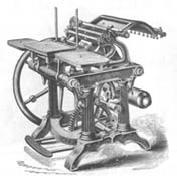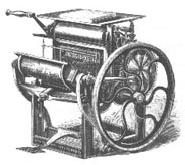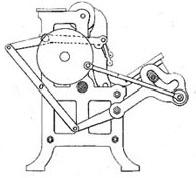|
ALONZO GILMAN (USA)
Patent No 3,716 - 1844 »
This was a self-inking jobbing press with a vertical bed and platen, brought together by toggle levers. A large ink distributing roller beneath the bed supplied ink to the roller frame. A frisket frame lifted between impress-ions to receive the stock.
This invention first appeared as Gilman's Jobber, and then from 1846 to 1873 as the Hoe Company's Patent Machine Card Press.
CHARLES W. HAWKES (USA)
Patent No. 7,413 - 1850
The patent for the platen jobbing press was manufactured as Hawke's Lion.
Patent No. 18,812 - 1857 »
The Magic Card Press, a self-inking clam-shell platen press with automatic card dropper and an ink drum below the type bed.
FRANKLIN L. BAILEY (USA)
Patent No. 16,109 - 1856 »
This press had a revolving ink cylinder behind the stationary type bed. Two inking rollers circulated entirely around this cylinder and over the type. The patent also covered a device for quick disconnection of platen from bed in case of a feeding incident.
Bailey took out a number of printing patents, and sold several of them to the Hoe Company. This one was assigned to Hoe in 1860.
G. H. BABCOCK (USA)
Patent No. 16,263 - 1856 »
Unusual clamshell platen powered by pressure from a foot lever. The bed receives its motion from which all others are derived - from this treadle direct. Downward movement on the combined hinged bed and curved ink distributor drew the platen down with it (similar motion to the Liberty Platen) causing the bed and platen to come together vertically. Counter weights acted to balance the whole. The forme was inked by two rollers and a rider assembly mounted rigidly to the frame and set in slots.
WILLIAM W. CLARKSON (USA)
Patent No. 20,039 - 1858
A crank-operated, self-feeding card press. A press based on this patent was produced for sale, and was demonstrated in the offices of the Scientific American in 1860.
C. POTTER JNR. & COMPANY (USA)
(Babcock's Patent) 1864 »
Somewhat 'old-fashioned' design (clamshell) platen which appears to have both bed and platen driven by toggles. Inkers were set into the frame and the type bed moved to and fro underneath them (similar to Degener's Liberty). Top inker oscillated sideways over the curved ink plate via a figure '8' cam race and follower.
H. S. CROPPER & CO. (UK)
Minerva Platen, 1867 »
The Minerva, also known as The Cropper, was a close copy of Geo. Gordon's 1862 'Franklin Jobber', according to Moran. It seems Cropper purchased the rights from Gordon. These presses were very popular in Gt. Britain and her colonies.
CINCINNATI PRG. MACH. WORKS
Nonpareil Jobber, 1868 »
The frame and bed was cast in one piece to which the working parts were attached. The platen was hinged to legs mounted to the base and front of frame. Strangely, later models dispensed with the superior drum ink distribution and reverted to the ink disk.
WALTER H. FORBRUSH (USA)
Patent No. 86,064; 1869
A platen jobbing press with stationary vertical type bed below a flat ink distributing surface in the same plane as the type. The lower part of the ink table oscillated sideways, for better distribution.
FREDERICK DEGENER (USA)
Patent No. 127, 316; 1872 »
A clam-shell platen incorporating a system of alternating cams and levers giving the requisite motion and dwell to the platen and roller arms. Independent roller carriers swiveled on a common pivot; ink distribution was via a large oscillating drum instead of the usual disk.
|
|
